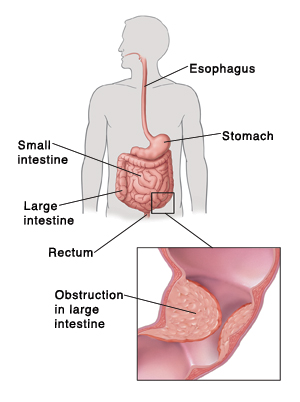A
B
C
D
E
F
G
H
I
J
K
L
M
N
O
P
Q
R
S
T
U
V
W
X
Y
Z
Topic IndexLibrary Index
Click a letter to see a list of conditions beginning with that letter.
Click 'Topic Index' to return to the index for the current topic.
Click 'Library Index' to return to the listing of all topics.
Large Bowel Obstruction
A large bowel obstruction occurs when part or all of the large intestine is blocked. (The large intestine is also called the large bowel or colon). As a result, waste can’t move through the bowel correctly and out of the body. Treatment is needed right away to manage the blockage. This can ease painful symptoms. It can also prevent serious problems, such as tissue death (necrosis) or bursting (rupture) of the large bowel. Without treatment, a large bowel obstruction may cause death.

Causes of large bowel obstruction
A large bowel obstruction can be caused by the following:
-
A growth or tumor that blocks the intestine, such as cancer
-
Twisting of the bowel around itself (volvulus)
-
A narrowing (stricture) of the bowel caused by scar tissue from conditions, such as diverticulitis and Crohn’s disease
-
Sliding of a part of the bowel into another part (intussusception)
-
A hard lump of stool (impacted feces)
Symptoms of large bowel obstruction
Common symptoms include:
Sometimes symptoms happen over weeks or months. These can include:
-
Changes in bowel habits
-
Unplanned weight loss
Diagnosing large bowel obstruction
Your healthcare provider will ask about your symptoms and health history. You’ll also have a physical exam. In addition, tests may be done to confirm the diagnosis. These can include:
-
Imaging tests. These provide pictures of the large bowel. Common tests include X-rays and a CT scan.
-
Blood tests. These check for infection and other problems, such as fluid loss (dehydration).
-
Air enema or contrast enema. One of these tests is done to take pictures inside the large bowel. A thin tube is inserted into the rectum through the anus. Then either air or contrast fluid is sent through the tube. This makes the bowel show up clearly on X-rays.
-
Colonoscopy. This procedure with anesthesia is done to examine the inside of the large bowel with a colonoscope (scope). The scope is a thin, flexible tube with a tiny camera on the end. It's inserted into your rectum through your anus. This lets your provider check for problems and collect tissue samples (biopsy), if needed. A shorter scope called a flexible sigmoidoscope or proctoscope may be used to see just the sigmoid colon or rectum.
Treating large bowel obstruction
Treatment takes place in a hospital. As part of your care, the following may be done:
-
No food or drink is given by mouth. This allows your bowels to rest.
-
An IV (intravenous) line is placed in a vein in your arm or hand. It’s used to give you fluids, nutrition, and medicines. These may be needed to ease pain and other symptoms. They may also be needed to treat or prevent infections.
-
A soft, thin, flexible tube (nasogastric tube) is inserted through your nose and into your stomach. The tube is used to remove extra gas and fluid in your stomach and bowels. An air or contrast enema may be done as well. It can remove gas or help clear a blockage.
-
In some cases of large bowel obstruction, procedures with a colonoscope are done as treatment. For instance, the scope may be used to straighten a twisted colon that is causing a blockage. Or, tools may be passed through the scope to make narrowed areas of the colon wider. Or to place a stent in the colon. A stent is an expandable tube-like device. Placing it in the colon can help ease the blockage.
-
Sometimes surgery is done as treatment for a large bowel obstruction. During surgery, the blockage is removed. If part of the bowel has died due to lack of blood flow, this must also be removed to prevent infection. The healthy ends of the bowel are then reconnected. If a long part of the bowel is removed, a small opening (stoma) may need to be made in the belly. This provides a new way for waste to leave the body. The stoma may be short-term (temporary) or long-term (permanent). Other repair may be done as well. This will depend on the cause and extent of the blockage.
-
Once treatment is done, you’ll be watched closely in the hospital until your symptoms improve. Your provider will tell you when can go home. If a stoma was made during surgery, you’ll be taught how to care for it correctly before leaving the hospital.
Long-term concerns
After treatment, many people recover with no lasting effects. If a long part of your bowel was removed, you’re at higher risk of lifelong digestive problems. Bowel movements may become irregular. If you have cancer or other long-term conditions, you’ll need to keep seeing your healthcare provider for treatment. Work with your provider to learn the best ways to manage your condition and to protect your health.
When to call the healthcare provider
Call your provider right away if you have any of these:
-
Fever of 100.4°F (38°C) or higher, or as advised by your provider
-
Chills
-
Belly swelling or cramping that won’t go away
-
Unable to pass stool or gas
-
Upset stomach (nausea) and vomiting
-
Increasing belly pain
-
Rectal bleeding or black, tarry stools
Online Medical Reviewer:
Marianne Fraser MSN RN
Online Medical Reviewer:
Rita Sather RN
Online Medical Reviewer:
Robyn Zercher FNP
Date Last Reviewed:
3/1/2024
© 2000-2024 The StayWell Company, LLC. All rights reserved. This information is not intended as a substitute for professional medical care. Always follow your healthcare professional's instructions.